When mixing perfumes, use the fragrance wheel as your guide to create harmonious blends by combining adjacent families or dynamic contrasts with opposite scents. Start with a 3:2:1 ratio of base, middle, and top notes, documenting every drop you add. Begin with simple two-note combinations like fresh citrus with florals, or woody bases with oriental spices. Always test small amounts first and let them develop for 30 minutes. These fundamental techniques unleash countless possibilities for crafting your signature scent.
Understanding Basic Scent Combinations on the Wheel

The fragrance wheel serves as your compass for creating enchanting perfume combinations.
When you're mixing scents, start by understanding how fragrance classification works: adjacent families naturally complement each other, while opposite families create dynamic contrasts.
You'll find that neighboring scent families share common characteristics. For example, you can blend floral notes with fresh fragrances to create an uplifting, spring-like aroma.
When you're feeling adventurous, try pairing opposite families, like woody fragrances with fresh ones, to develop complex and intriguing combinations.
For perfume creation that's truly sophisticated, consider using the triangle technique: select three related subfamilies from different sections of the wheel.
This approach guarantees you'll create well-balanced scents with harmonious top, middle, and base notes that work together seamlessly.
Balancing Top, Middle, and Base Notes
When mixing your own fragrance blend, start with base notes as your foundation, using about 30% of your total composition to create lasting depth with ingredients like vanilla or woods.
Next, build your middle notes at roughly 50% of the mixture, incorporating floral or herbal elements that'll connect smoothly with both your base and top layers.
Finally, add your top notes at 20% of the total, selecting bright citrus or fruit elements that complement your other layers while creating an enticing first impression.
Building Your Scent Layers
Creating a perfectly balanced perfume requires understanding the classic three-tier structure of fragrance composition.
You'll want to start by selecting complementary scent families using the fragrance wheel, guaranteeing your choices blend well together for a harmonious olfactory experience.
- Begin with top notes like citrus or herbs, making up 20-30% of your blend for an energetic first impression.
- Layer in middle notes, comprising 50-70% of your fragrance, using florals and spices to create the heart of your scent.
- Add base notes at 15-30% to anchor your creation with rich, lasting elements like vanilla or musk.
- Select scents from neighboring fragrance wheel families for harmony, or opposite families for contrast.
This structured approach guarantees your perfume develops beautifully from the initial spritz through its final lingering notes.
Proportions For Perfect Balance
Mastering the art of perfume mixing requires precise proportions to achieve a balanced, long-lasting fragrance. To create a harmonious balance among fragrance families, follow the 30-50-20 rule: use 30% top notes, 50% middle notes, and 20% base notes in your blend.
Start with your top notes, incorporating light, fresh scents like citrus that'll provide the initial impression.
Then, build your core with middle notes, focusing on floral or soft woody elements that'll form the heart of your fragrance.
Finally, anchor your blend with base notes using rich ingredients like vanilla or musk sparingly.
Blending Adjacent Note Families
The art of blending adjacent note families relies on understanding the natural harmony between neighboring scents on the fragrance wheel.
When you're creating your signature scent, you'll find that adjacent families naturally complement each other, creating a balanced and sophisticated fragrance profile.
- Start with a Fresh family top note, then select a Floral middle note, and finish with a Woody base note
- Choose scents from neighboring families like Floral and Fruity to maintain harmony
- Create a triangle formation on the fragrance wheel to guarantee depth and complexity
- Experiment with subtle variations within adjacent families to develop a unique, cohesive scent
Starting With Simple Two-Note Blends
When you're ready to venture into perfume mixing, starting with simple two-note blends offers the perfect foundation for understanding fragrance dynamics.
Using the fragrance wheel as your guide, look for notes that share complementary characteristics in adjacent families. You'll find success by pairing a fresh top note, like citrus, with a floral blend that creates an uplifting aromatic fragrance.
For a balanced composition, try combining a woody base note such as sandalwood with floral notes like jasmine. This creates a harmonious blend of depth and delicacy.
Don't be afraid to experiment with contrasting notes from opposite families on the wheel – like spicy and fresh combinations – to develop unique and engaging scents. These intentional pairings will help you master the basics of fragrance creation while training your nose to recognize successful combinations.
Exploring Complementary Scent Families
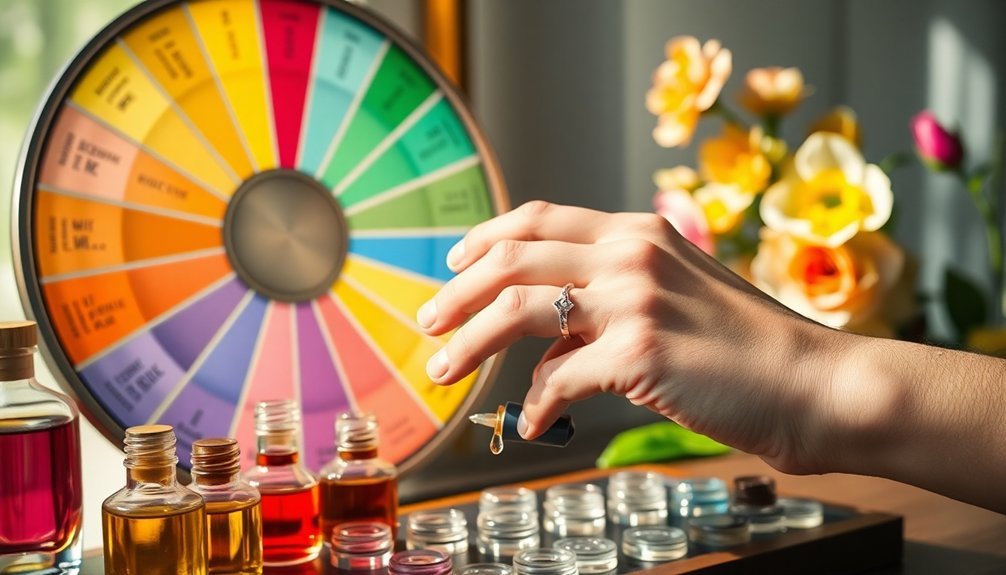
Building on your two-note blend experience, complementary scent families open up a world of enchanting fragrance possibilities.
You'll find these contrasting notes directly across from each other on the fragrance wheel, creating unique fragrance experiences that balance and intrigue. By pairing opposites, like Amber with Marine notes, you're unleashing creative experimentation opportunities that can transform your personal fragrance collections.
- Identify complementary pairs by looking across the fragrance wheel
- Start with classic combinations like warm and fresh notes
- Test small amounts before committing to larger blends
- Document successful pairings for future reference
When you understand how complementary scent families work together, you'll be equipped to craft signature scents that truly stand out.
This approach helps you break away from conventional fragrances while maintaining harmony in your creations.
Measuring and Recording Your Mixtures
To create consistent and replicable perfume blends, you'll need to document every drop of fragrance you add using a precise scale and detailed notes.
Your mixing journal should track the exact ratios between top, middle, and base notes, along with the date and specific ingredients used in each blend.
Label all your storage containers with the blend name, date, and composition details to maintain an organized and professional approach to your perfume-making journey.
Document Every Drop Added
The art of perfume mixing demands meticulous record-keeping for every drop and measurement you add to your blends.
You'll need to document each ingredient's scent family and track how different fragrance notes interact on the fragrance wheel. Keep detailed proportions of every component you use, as even the smallest variation can alter your final creation.
- Use pipettes and graduated cylinders to measure precise amounts
- Track each ingredient's scent family and subfamily
- Record how fragrances evolve over time through top, middle, and base notes
- Store samples in labeled vials for future reference
Your journal becomes your perfume-making compass, helping you replicate successful blends and avoid previous mistakes.
Don't forget to note how different fragrance notes interact and develop throughout the day, as this information proves invaluable for future formulations.
Track Fragrance Note Ratios
Precise measurement and documentation of fragrance note ratios serve as the foundation for successful perfume creation. To track fragrance note ratios effectively, you'll need either a scale or measuring pipette to guarantee accuracy when blending your scents.
When you blend fragrances, start with small batches and carefully record the exact measurements of each fragrance component in a dedicated notebook or digital app. Create a clear labeling system that includes the names of your scents, their fragrance families, and the specific ratios you've used. This organized approach helps you understand which scents can work together harmoniously.
Remember to review your recorded mixtures regularly, noting how the fragrances develop over time. This practice will help you refine your blending techniques and adjust ratios for better results in future creations.
Label Storage Containers Properly
While creating your signature fragrances, proper labeling of storage containers plays an essential role in maintaining accurate records of your perfume blends.
Use a permanent marker or waterproof labels to document the fragrance name, date of creation, and precise measurements. Keep detailed notes of your mixing process, including fragrance wheel positions and any adjustments you've made along the way.
- Record scent characteristics and personal impressions to guide future blending decisions
- Use clear, legible writing to guarantee accurate replication of successful formulas
- Store containers in a cool, dark environment to maintain fragrance integrity
- Document each ingredient's measurements precisely for consistent results
Mastering the Triangle Technique
Mastering fragrance blending becomes achievable when you understand the Triangle Technique, a method that combines three complementary scent families from the fragrance wheel.
You'll select fragrances that form a triangular pattern on the wheel, ensuring each scent contributes to a harmonious blend.
To implement this technique effectively, you'll need to choose one fragrance from each of your selected families. For example, you might pair floral notes with oriental spices and fresh citrus elements.
This combination creates a dynamic, well-balanced scent profile that's uniquely yours. The beauty of this method lies in its structured approach to creativity – you're free to experiment within the framework while maintaining balance between woody notes, fresh notes, or any other families you choose.
It's an excellent way to craft your signature scent.
Creating Signature Scents With Adjacent Families
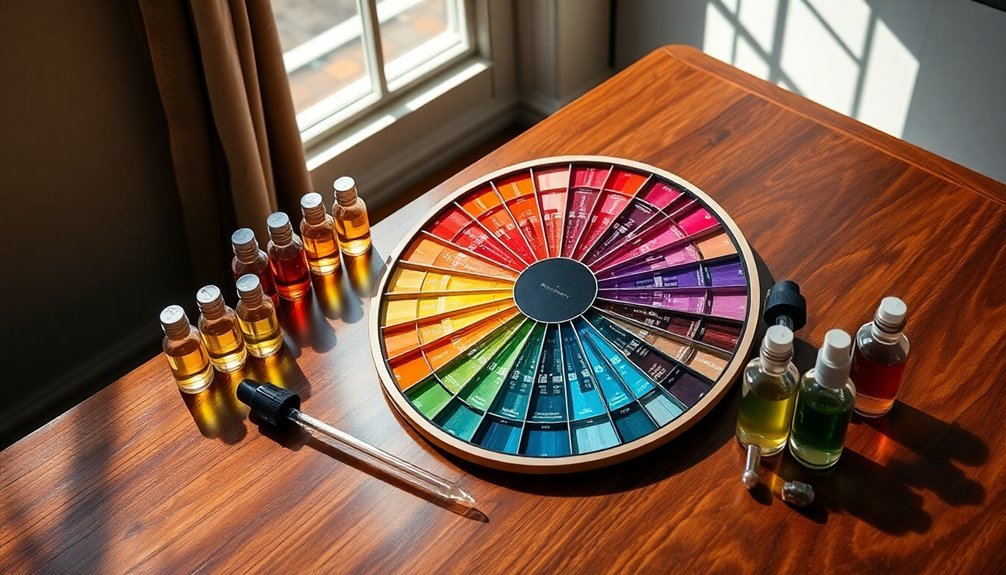
You'll discover remarkable results when you combine fragrances from neighboring families on the fragrance wheel, such as floral with fresh or woody with amber.
The natural harmony between adjacent scent families allows you to create well-balanced signature fragrances that feel sophisticated and intentional.
Blending Similar Scent Notes
Creating your signature scent becomes more intuitive when you focus on blending fragrances from adjacent families on the fragrance wheel. By understanding how similar scent notes work together, you'll create harmonious combinations that reflect your personal style.
For example, combining Fresh and Floral families lets you pair citrus with soft floral notes for a balanced, uplifting aroma.
- Mix lavender from the Floral family with lemon from the Fresh family for a calming yet vibrant blend
- Explore triangle formations on the fragrance wheel to add depth using three related scent families
- Combine fruity florals with soft orientals to create unique signature scents
- Look for kindred aromatic notes that share common characteristics for familiar, well-balanced results
This strategic approach to blending guarantees your custom fragrance maintains harmony while expressing individuality.
Layering Complementary Fragrance Families
While discovering your perfect signature scent, layering complementary fragrance families opens up a world of sophisticated combinations. By using the fragrance wheel as your guide, you'll find that adjacent families share characteristics that blend harmoniously together.
You can create unique and personalized fragrances by pairing Floral scents with Woody scents, leveraging their natural compatibility. For a light and airy feel, try combining Soft Floral with Fresh notes.
If you're seeking a more luxurious signature scent, blend Amber with Woody scents like sandalwood for a rich, lasting impression.
The Neighbor Fragrance Technique makes it easy to experiment with subfamilies that sit close to each other on the wheel. This approach guarantees your layered combinations complement rather than compete, resulting in a beautifully balanced fragrance that's distinctly yours.
Testing and Adjusting Fragrance Ratios
Once you've selected your fragrance components, testing and adjusting their ratios becomes a delicate balancing act. Start with your base fragrance and slowly introduce complementary scents, following the fragrance wheel's guidance to achieve harmony.
You'll want to carefully document each ratio as you test your mixture, allowing the notes to settle before making further adjustments.
- Keep a detailed log of each blend's proportions, noting which combinations work best
- Test small amounts first on fragrance strips, then on your skin
- Wait at least 30 minutes for the notes to fully develop before making adjustments
- Maintain a 3:2:1 ratio between your base, middle, and top notes
Remember to balance notes throughout the entire fragrance development process, ensuring your final creation has the depth and longevity you're seeking.
Take your time – perfection in perfumery comes through patient experimentation.
Blending Seasonal Perfume Combinations
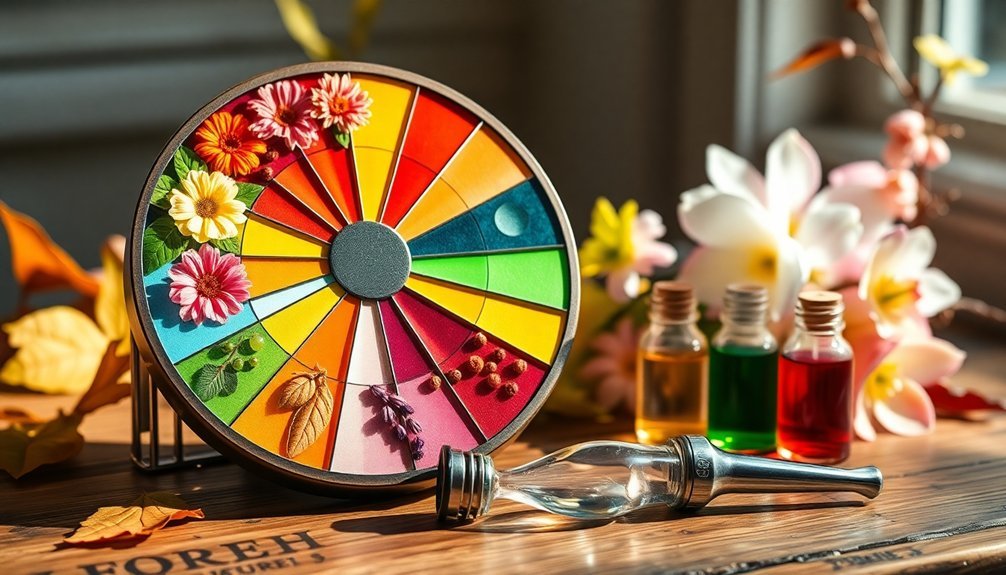
The art of seasonal perfume blending adds another layer to your fragrance-making journey. Using the fragrance wheel as your guide, you'll discover perfect combinations that capture each season's essence.
For spring, try blending floral jasmine with fresh bergamot to create an uplifting scent that celebrates nature's renewal.
Summer calls for bright combinations like grapefruit and sea salt, evoking memories of beach days and ocean breezes.
When autumn arrives, explore woody cedarwood paired with vanilla amber for a cozy, sophisticated aroma.
Winter's spicy-gourmand combinations, like cinnamon and caramel, bring warmth and festivity to cold days.
Remember to test your seasonal blends carefully, adjusting proportions until you've captured the perfect balance that reflects each season's unique character and mood.
Storing and Preserving Your Custom Blends
Inside your fragrance-making journey, proper storage and preservation techniques serve as essential guardians of your custom blends. To protect your creations, store them in dark glass bottles away from sunlight and heat sources, ensuring ideal longevity.
You'll want to track freshness by labeling each blend with creation dates and ingredients, making future recreations effortless.
- Allow your blends to mature for several weeks, enhancing their complexity
- Keep bottles in a cool, dry environment to maintain scent stability
- Regularly check changes in color or fragrance to detect potential degradation
- Store custom blends in dark glass containers to shield from harmful light exposure
Remember to periodically assess your perfumes for any signs of spoilage, and don't hesitate to discard blends that show concerning changes.
These preservation practices will help maintain the integrity of your unique fragrances for extended periods.
Frequently Asked Questions
What Is the 30/50/20 Rule for Perfume?
Your perfume blend should follow the 30/50/20 rule: use 30% top notes for initial impact, 50% middle notes for the heart of your fragrance, and 20% base notes for lasting depth.
What Is the Best Way to Mix Perfume?
You'll get the best results by using the fragrance wheel to identify complementary scents, starting with a 30/50/20 ratio. Test small amounts on your skin first, and adjust the proportions until you're satisfied.
How to Know What Scents Go Well Together?
You'll find compatible scents by looking for adjacent notes on the fragrance wheel. Choose kindred scents that sit next to each other, or try opposite notes for contrast. Test small combinations first.
Where Does Vanilla Sit on the Fragrance Wheel?
You'll find vanilla in the Amber family on the fragrance wheel. It's positioned among warm, sweet notes and sits close to oriental resins like benzoin and myrrh, making it perfect for cozy combinations.
In Summary
Now that you've learned the art of mixing perfumes using the fragrance wheel, you're ready to start creating your own signature scents. Remember to trust your nose, keep detailed notes of your successful combinations, and don't be afraid to experiment. With practice, you'll develop an intuitive understanding of how different fragrance families work together. Start with simple blends and gradually build your confidence in perfume mixing.
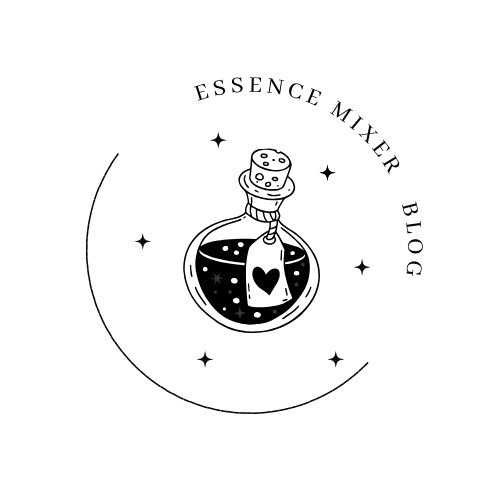
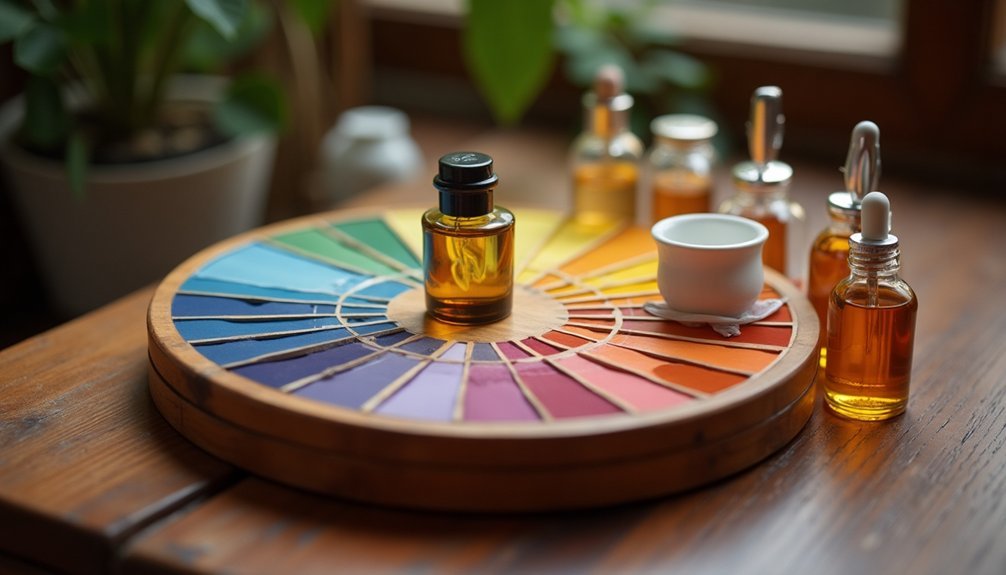



Leave a Reply